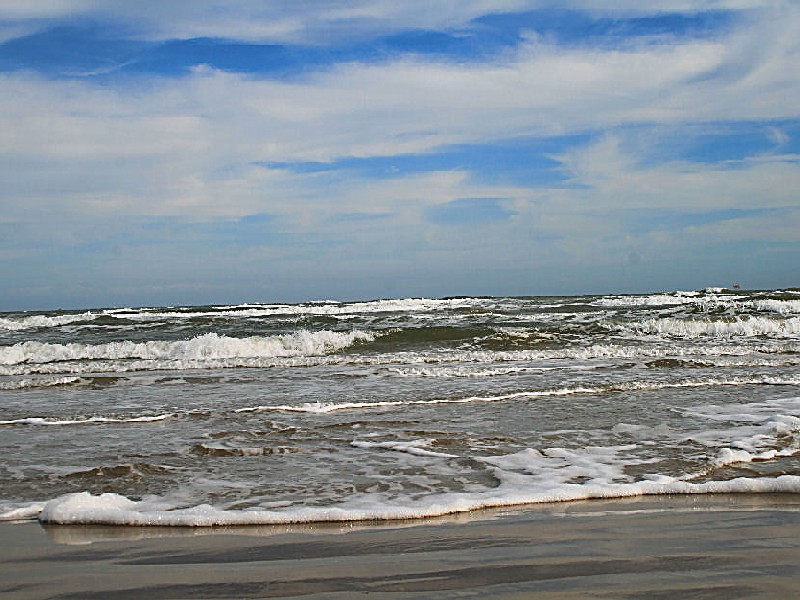
A., 1980, Padre Island National Seashore: A Guide to the Geology, Natural Environments, and History of a Texas Barrier Island: The University of Texas at Austin, Bureau of Economic Geology, Guidebook 17, 94 p. Because this book is designed for an audience with a wide range of interests, education, and experience, the text should prove useful and interesting to geologists and students as well as to the casual island observer." The guide also presents summaries of the geologic origin and history of Padre, as well as the history of human use of the island and interaction with the natural environments. A road log for a short field trip directs readers to these environments and effects of the active processes. This guide to Padre Island National Seashore describes and explains island and lagoon environments, the active processes that constantly change the face of Padre, and natural records left by those processes. This is Padre Island-where shipwrecked Spaniards were once pursued and massacred by fierce Karankawa Indians where Pat Dunn's vaqueros herded thousands of cattle in preparation for trips to the market and where now almost a million visitors every year spread out along the miles of sandy and shelly beaches to enjoy the untamed beauty of Padre Island National Seashore. "Stretching 113 miles under the South Texas sun is the longest barrier island in the United States. Gulf Coast Association of Geological Societies.Wilcox Group, East Texas, Geological / Hydrological Folios.

Environmental Geologic Atlas of the Texas Coastal Zone.Atlases of Major Oil and Gas Reservoirs.(Note that driving behind the dunes is STRICTLY prohibited there are delicate ecosystems here. This is where South Beach begins-from this point, there are 60 miles of open beach waiting to be explored. To get to the part of the park where you can drive on the beach, continue on Park Road 22 (the main paved road) until the pavement ends. If you have a high-clearance, 4-wheel drive vehicle, exploring the island’s most remote areas by car is a uniquely thrilling experience. It is easy to confuse the two beaches since they are two ends of the same Padre Island National Seashore, their names are nearly identical, and they both border. You can take your own kayak or canoe, or rent one from the park’s concessionaire. One of just a few hypersaline lagoons in the world, the Laguna Madre offers great kayaking and canoeing opportunities. Or go beachcombing along the seashore-there are always treasures to be found here. Is there anything better than a leisurely hike or bike ride along the ocean’s edge? Bring your bicycle and ride it along South Beach, where you’ll likely have most of the shores to yourself (depending on how far down you go).

Visitors may fish along the entire length of the Gulf, in the Laguna Madre, and at Bird Island Basin and Yarborough Pass.
SOUTH BEACH PADRE ISLAND NATIONAL SEASHORE LICENSE
To fish anywhere in the park, you must have a valid Texas fishing license and a saltwater stamp, both of which you can acquire outside of the park at a local tackle shop or gas station. Call the Malaquite Visitor Center (36) to schedule a tour with a volunteer birding guide. There have been more than 380 species of birds sighted at the park, which represents nearly half of all the documented bird species in North America.

Padre Island is an important destination for migratory birds, and as such, it’s an exceptional place for birdwatching. (Because the park can’t predict when a sea turtle will hatch, check their Current Nesting Season page and the Sea Turtle Program Facebook page for up-to-date info on releases.) Most hatchling releases occur from mid-June through August. During the summer, staff members release sea turtle hatchlings from nests laid in the park and along the coast, and visitors can sometimes catch these if the timing is right. Since 1978, the park has been a participant in the effort to save the Kemp’s ridley sea turtle. Never swim alone and always use extreme caution when swimming currents can be strong.

Visitors can swim in the recreation area at Bird Island Basin or in the Gulf, but do note that there are no lifeguards on duty.


 0 kommentar(er)
0 kommentar(er)
